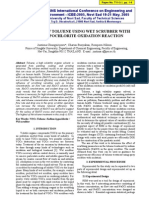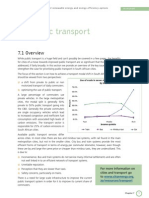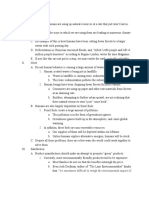PUV Position Paper
PUV Position Paper
Uploaded by
rosendasaranza46Copyright:
Available Formats
PUV Position Paper
PUV Position Paper
Uploaded by
rosendasaranza46Original Title
Copyright
Available Formats
Share this document
Did you find this document useful?
Is this content inappropriate?
Copyright:
Available Formats
PUV Position Paper
PUV Position Paper
Uploaded by
rosendasaranza46Copyright:
Available Formats
Modernizing Public Transport in the Philippines: Beneficial or Not?
The modernization of Public Utility Vehicles (PUVs) is an essential step towards improving
the transportation system in our country. By embracing this change, we can address the
existing issues and bring about numerous benefits. The purpose of this position paper is to
advocate for the implementation of PUV modernization and highlight its positive impact on
the economy, environment, and overall quality of life in our society.
(A1)One of the primary reasons to support PUV modernization is to enhance efficiency and
safety in our transportation system. Modern PUVs are equipped with advanced technology,
such as GPS tracking, which allows for better route planning and monitoring. This improves
the reliability of schedules, reduces waiting times, and ensures a smoother commute for
passengers. According to a report by the Philippine Statistics Authority, there were 12,799
and 8,017 road crash incidents involving public utility vehicles, including jeepneys (old or
new), in 2019 and 2020. Consequently, modern PUVs are designed with safety features like
airbags, ABS brakes, and CCTV cameras, providing a secure and comfortable journey for
commuters.
(A2)PUV modernization plays a crucial role in promoting environmental sustainability.
Traditional jeepneys and buses contribute significantly to air pollution due to outdated
engines and excessive emissions. According to DENR, accounting for approx. 30% of
energy-related GHG emissions, transport is noted as the largest source of air pollution in
the Philippines. In 2015, road transport GHG emissions were estimated at 28.4 MtCO2e, of
which the Jeepney sector alone accounts for 15.5%. With the adoption of modern PUVs, we
can reduce greenhouse gas emissions and improve air quality, leading to a healthier
environment for everyone. Electric and hybrid vehicles are also part of the modernization
plan, which further reduces our carbon footprint and contributes to the global efforts in
combating climate change.
(A3)The modernization of PUVs brings with it numerous economic benefits. Firstly, it
creates job opportunities for skilled labor in the manufacturing, maintenance, and
operation of modern vehicles. This boosts the local economy and contributes to the overall
growth of our nation. Secondly, modern PUVs are more fuel-efficient, leading to cost
savings for both operators and commuters. With reduced fuel consumption, operators can
allocate resources for vehicle upgrades and offer competitive fares, while commuters can
enjoy lower transportation expenses. This would align with the global target of the United
Nation's SDG to reach net-zero emissions by 2050, which is crucial in addressing the issue
of climate change.
The new PUVs are built to international standards and comply with the standards set by the
Bureau of Philippine Standards Philippine National Standards. By embracing PUV
modernization, we can improve accessibility and convenience for all commuters. Modern
PUVs are designed to be more inclusive, with features like ramps and priority seating for
the elderly and persons with disabilities. Additionally, the implementation of a cashless
payment system enables a seamless and hassle-free experience for passengers. These
advancements ensure that everyone, regardless of their age or physical abilities, can travel
comfortably and independently.
Despite the numerous benefits of PUV modernization, there may be resistance from
various stakeholders, including operators and drivers who fear job loss or increased
operating costs. The Land Transportation Franchising and Regulatory Board said that
38,000 drivers could lose their jobs, based on the number of unconsolidated jeepneys as of
January 2024. To overcome this resistance, it is crucial to provide adequate support and
assistance, such as training programs and financial incentives, to facilitate the transition to
modern PUVs. Ultimately, the long-term benefits of improved efficiency, safety,
environmental sustainability, and economic growth outweigh the initial challenges.
In conclusion, the modernization of PUVs is a necessary step towards transforming our
transportation system for the better. By embracing this change, we can enhance efficiency
and safety, promote environmental sustainability, generate economic benefits, and
improve accessibility and convenience for all. It is essential to address the concerns of
stakeholders and provide the necessary support to ensure a smooth transition. Let us work
together to build a modern and sustainable transportation system that benefits both
present and future generations.
References:
https://ltfrb.gov.ph/puv-modernization-program/
https://changing-transport.org/modernizing-public-transport-in-the-philippines/
https://www.linkedin.com/pulse/modernizing-jeepney-fleet-philippines-balancing-safety-cartojano
https://www.rappler.com/business/anti-poor-government-defends-puv-modernization-jeepney-
stakeholders-oppose-it/
https://www.philstar.com/headlines/2023/11/17/2312065/ltfrb-firm-puv-modernization-
consolidation-deadline/amp/
You might also like
- Test - API 1169 - QuizletDocument13 pagesTest - API 1169 - QuizletAkram Alhaddad33% (3)
- 3.treatment of Toluene Using Wet Scrubber With Sodium Hypochrolite Oxidation ReactionDocument4 pages3.treatment of Toluene Using Wet Scrubber With Sodium Hypochrolite Oxidation ReactionMehul DesaiNo ratings yet
- CHAPTER II CioDocument9 pagesCHAPTER II CioMordecai SaceNo ratings yet
- Advantages of Modern JepneyDocument3 pagesAdvantages of Modern JepneyRon AgamataNo ratings yet
- EPA National Emissions Inventory: Air Pollution WebquestDocument4 pagesEPA National Emissions Inventory: Air Pollution Webquestforod91100mxclipcomNo ratings yet
- Statement of The ProblemDocument2 pagesStatement of The ProblemJohn Erick Oro ApaapNo ratings yet
- Debate Positive Side Uge 1Document6 pagesDebate Positive Side Uge 1cyriljunaicamaranquezNo ratings yet
- RRLDocument6 pagesRRLmaeguirhem120917No ratings yet
- 8860+-+A N +calva+2755+-+2774Document20 pages8860+-+A N +calva+2755+-+2774sc.edhearvy.llamesNo ratings yet
- Marketingplan Compasshorizon No References File 2Document7 pagesMarketingplan Compasshorizon No References File 2ysasempio03No ratings yet
- Advocacy For The Modernization of The Jeepneys in The PhilippinesDocument1 pageAdvocacy For The Modernization of The Jeepneys in The PhilippinesblimcastroNo ratings yet
- Eng-Debate 2Document3 pagesEng-Debate 2gundranjhayraNo ratings yet
- Position-Paper TemplateDocument3 pagesPosition-Paper TemplatebroNo ratings yet
- 1 - G ENGL101 - EA Lesson 7.5Document12 pages1 - G ENGL101 - EA Lesson 7.5NOMIAZ GALDENo ratings yet
- MonteDocument2 pagesMonte21-1-01842No ratings yet
- PUV Modernization ProgramDocument7 pagesPUV Modernization ProgramPrincess Janine CatralNo ratings yet
- Puv Modernization Program FinalDocument5 pagesPuv Modernization Program FinalCaryll CaleoNo ratings yet
- FLEET MODERNIZATION - FinalDocument3 pagesFLEET MODERNIZATION - Finalblu.ren127No ratings yet
- Researches: Jeepney Modernization LTFRBDocument3 pagesResearches: Jeepney Modernization LTFRBclarence calamiongNo ratings yet
- Assignment MethodsDocument6 pagesAssignment MethodsUnknwn UknwonNo ratings yet
- Jeep ModernizationDocument10 pagesJeep ModernizationErlle AvllnsaNo ratings yet
- RRL 2Document10 pagesRRL 2labajo.shaira24No ratings yet
- CASE ANALYSIS_HURAÑO & MAISODocument8 pagesCASE ANALYSIS_HURAÑO & MAISOJulianna HurañoNo ratings yet
- RRL ResearchDocument18 pagesRRL ResearchJerald CruzNo ratings yet
- Jeepney Phaseout (Affirmative Side) (Necessary)Document1 pageJeepney Phaseout (Affirmative Side) (Necessary)clarence calamiongNo ratings yet
- ETHICS Final Research PaperDocument13 pagesETHICS Final Research PaperjohannmanlunasNo ratings yet
- Activity 1Document5 pagesActivity 1Vincentsam MoratallaNo ratings yet
- Document (7)Document3 pagesDocument (7)rainieraletanaranjo22No ratings yet
- PC101Document3 pagesPC101Angeline BauzonNo ratings yet
- Is33 SeatworkDocument2 pagesIs33 Seatwork20210023451No ratings yet
- Of The) Republic of The Philippines) : First Regular SessionDocument7 pagesOf The) Republic of The Philippines) : First Regular SessionRalph RectoNo ratings yet
- Advantages of JeepneyDocument3 pagesAdvantages of JeepneyCarl James L. MatrizNo ratings yet
- Chapter 1 2 1Document32 pagesChapter 1 2 1accel sillaNo ratings yet
- Position PaperDocument2 pagesPosition PaperKhylene Zhen100% (1)
- BSM084 Project Management Fundamentals Talib HussainDocument20 pagesBSM084 Project Management Fundamentals Talib Hussaineng.nasir507No ratings yet
- Public Transport: 7.1 OverviewDocument11 pagesPublic Transport: 7.1 OverviewTumelo MohlakeNo ratings yet
- Hybrid Electric and Battery Electric Vehicles - Measures To Stimulate UptakeDocument43 pagesHybrid Electric and Battery Electric Vehicles - Measures To Stimulate UptakeAndrew DanielNo ratings yet
- The Fall of The Philippines' Kings of The RoadDocument3 pagesThe Fall of The Philippines' Kings of The Roadzara perez100% (1)
- Jeeney ModernizationDocument1 pageJeeney ModernizationJames Leonard MunezNo ratings yet
- ResearchDocument21 pagesResearchmaeguirhem120917No ratings yet
- Bajpai and Bower 2020 Policy BriefDocument7 pagesBajpai and Bower 2020 Policy Briefmèo blinksNo ratings yet
- Guialel, Mapa, Moreno, Naraiso, PolinarDocument17 pagesGuialel, Mapa, Moreno, Naraiso, PolinarCarl June NaraisoNo ratings yet
- Tanishtha Gupta NetajiSubhasUniversityofTechnologyDocument3 pagesTanishtha Gupta NetajiSubhasUniversityofTechnologyAbhinav GoyalNo ratings yet
- Introduction/RationaleDocument5 pagesIntroduction/RationalemaryNo ratings yet
- Chapter_1Document8 pagesChapter_1Panashe Doreen ChitsikeNo ratings yet
- ENV3001 - 複製 (2)Document14 pagesENV3001 - 複製 (2)oscarlung1993No ratings yet
- Mass Transportation ScriptDocument6 pagesMass Transportation ScriptClarisse Joy DonguinesNo ratings yet
- Position PaperDocument9 pagesPosition PaperMARION JUMAO-AS GORDONo ratings yet
- MR On Electric VechileDocument43 pagesMR On Electric VechileDurgallaa PreethamNo ratings yet
- The Downside of PUVMPDocument3 pagesThe Downside of PUVMPPaul Andrei JardiolinNo ratings yet
- rph with reflectionDocument3 pagesrph with reflectionpotatersNo ratings yet
- ASSURED Clean Bus Report Final2 (1)Document175 pagesASSURED Clean Bus Report Final2 (1)David Gabriel CarrascoNo ratings yet
- Case Study 2.1Document2 pagesCase Study 2.1Patricia Solomon CapiliNo ratings yet
- Position Paper On The Jeepney Phase-Out in The PhilippinesDocument8 pagesPosition Paper On The Jeepney Phase-Out in The PhilippinesJhelboy BarabadNo ratings yet
- RRL 1Document9 pagesRRL 1JannenNo ratings yet
- EntrepreneurialMind_Chapters1-5_Group6 (1)Document14 pagesEntrepreneurialMind_Chapters1-5_Group6 (1)anonymous231personNo ratings yet
- Decarbonising Urban TransportDocument7 pagesDecarbonising Urban TransportSamiksha KheleNo ratings yet
- DOC-20241119-WA0036.Document4 pagesDOC-20241119-WA0036.mohammedxdpro2024No ratings yet
- TempDocument5 pagesTemptempestv944No ratings yet
- Tolentino Janaustino As1m1Document6 pagesTolentino Janaustino As1m1Frans JulianNo ratings yet
- FINAL ENG Policy Brief FES OnlineDocument36 pagesFINAL ENG Policy Brief FES OnlineEslam MansourNo ratings yet
- Review of Related Literature and Studies: Taguig City UniversityDocument9 pagesReview of Related Literature and Studies: Taguig City UniversityklintNo ratings yet
- The Future of Transportation: Innovations in Mobility and SustainabilityFrom EverandThe Future of Transportation: Innovations in Mobility and SustainabilityRating: 1 out of 5 stars1/5 (1)
- MSDS AAY0953.PDF - Topcoat YellowDocument7 pagesMSDS AAY0953.PDF - Topcoat YellowdevdossbNo ratings yet
- Concept of Green Energy by Mariya Iftekhar - WPS OfficeDocument22 pagesConcept of Green Energy by Mariya Iftekhar - WPS OfficeSavvy Malik100% (1)
- Test 1 ECE CDB3022 - CEB3013 - May 2020Document7 pagesTest 1 ECE CDB3022 - CEB3013 - May 2020Ahmed AlwaqediNo ratings yet
- Pts 5 New - Docx (1) JASPREET SINGHDocument10 pagesPts 5 New - Docx (1) JASPREET SINGHronak57775No ratings yet
- NEA General Requirements To Be Complied With at Development Control & Building Plan StageDocument4 pagesNEA General Requirements To Be Complied With at Development Control & Building Plan StageGeraldNo ratings yet
- Impacts On Air Environment: Prediction and Assessment ofDocument42 pagesImpacts On Air Environment: Prediction and Assessment ofDhruv YadavNo ratings yet
- Outline Persuasive SpeechDocument3 pagesOutline Persuasive SpeechRik GhoshNo ratings yet
- Data Sheet HFE-72DEDocument4 pagesData Sheet HFE-72DEsshaffer_9No ratings yet
- Elements of Spatial Disorders: in The Philippine ContextDocument41 pagesElements of Spatial Disorders: in The Philippine ContextJC DoloritoNo ratings yet
- Lab Vent Chem Hoods PresentationDocument42 pagesLab Vent Chem Hoods PresentationNelson VargasNo ratings yet
- Section B Description FinalDocument33 pagesSection B Description FinalNegama ThullahNo ratings yet
- 01 Introduction To Building ServicesDocument17 pages01 Introduction To Building ServicesAr Anuj ChandraNo ratings yet
- Project Information Sheet: Design and Construction of A Elv-Windscreen Recycling Line (WS-REC)Document2 pagesProject Information Sheet: Design and Construction of A Elv-Windscreen Recycling Line (WS-REC)Leandro PeçanhaNo ratings yet
- CFD Analysis of Exhaust ManifoldDocument24 pagesCFD Analysis of Exhaust ManifoldkummethasivasankarNo ratings yet
- Mosque LoudspekersDocument34 pagesMosque LoudspekersArun SharmaNo ratings yet
- AFR Fact Sheet: Fly Ash AFR Co-Processed Volume ('000 T)Document1 pageAFR Fact Sheet: Fly Ash AFR Co-Processed Volume ('000 T)Safrin SangiaNo ratings yet
- Pollution (Water, Land, Air)Document7 pagesPollution (Water, Land, Air)DASE GamingNo ratings yet
- MSDS CitricAcidAnhydrousDocument7 pagesMSDS CitricAcidAnhydrousSewanu AvosehNo ratings yet
- Euro Emission StandadrdsDocument3 pagesEuro Emission StandadrdsOzair Ali KhanNo ratings yet
- Vinyl Chloride ProductionDocument44 pagesVinyl Chloride ProductionHemant Rathva100% (1)
- Air Pollution Is The Contamination of The Indoor or Outdoor Environment by Any ChemicalDocument2 pagesAir Pollution Is The Contamination of The Indoor or Outdoor Environment by Any ChemicalMuhammad Raka Yudi AthallahNo ratings yet
- 2022 - IIT Kanpur - UPPCB - Final-Report-Kanpur-Source Apportionment and Emission InventoryDocument364 pages2022 - IIT Kanpur - UPPCB - Final-Report-Kanpur-Source Apportionment and Emission InventoryKUNDESHWAR PUNDALIKNo ratings yet
- Enclosed Ground Flare RGBDocument4 pagesEnclosed Ground Flare RGBSibin CherianNo ratings yet
- Est MicroprojectDocument13 pagesEst MicroprojectPriyanka BhideNo ratings yet
- Environmental AwarenessDocument29 pagesEnvironmental AwarenessradhabobbyNo ratings yet
- What Is The Wind EnergyDocument6 pagesWhat Is The Wind EnergyAbigail HugoNo ratings yet
- Thesis Chapter 1Document11 pagesThesis Chapter 1Mannuel Ignacio Matillano100% (1)

























































































